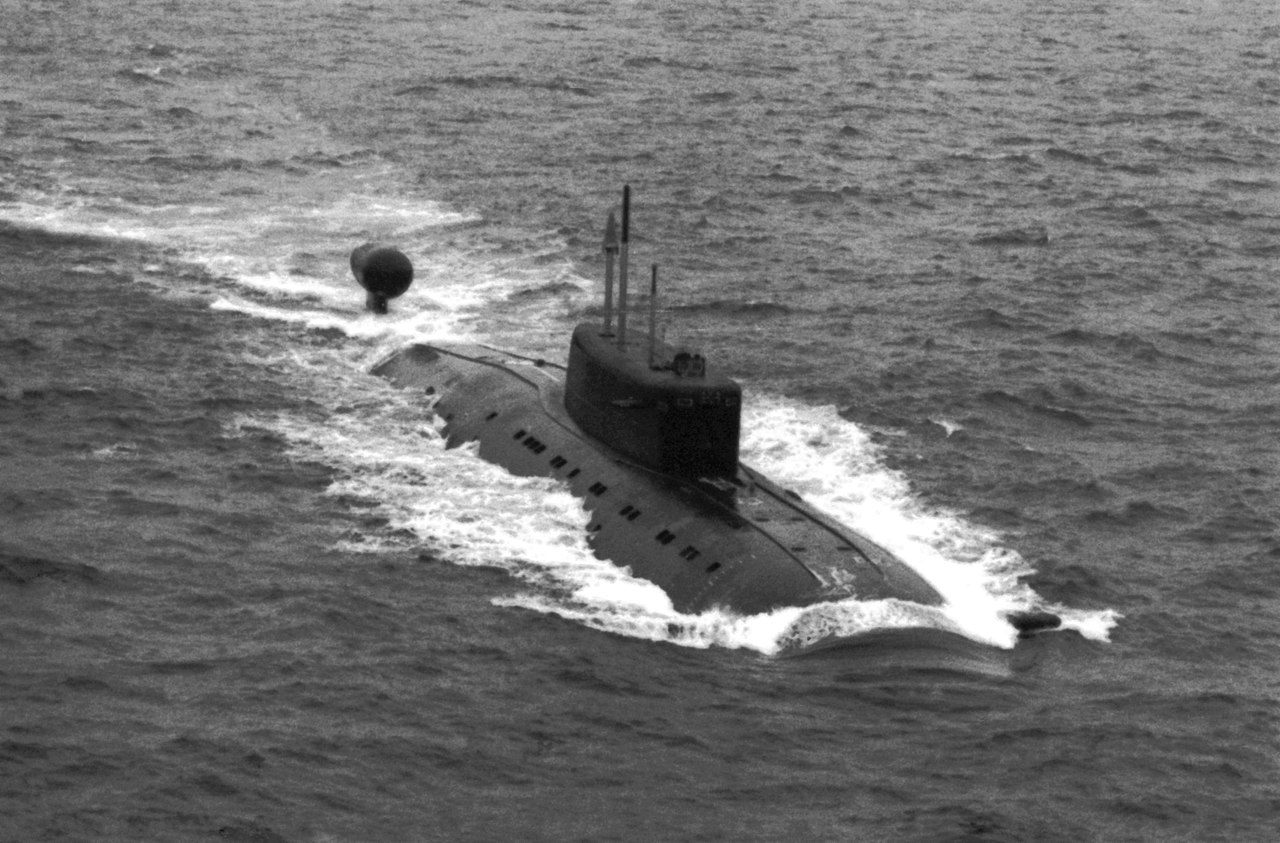

美國20151106日報導,五角大廈官員證實,一艘俄羅斯“塞拉II級”(Sierra II)核子攻擊潛艦上月在美國東海岸以南275英里(約442公里)處被美國海軍發現。
該潛艇正在對部署於金斯灣基地的美國核潛艇執行情報搜集任務。金斯灣海軍潛艇基地位於佛羅里達州東北部傑克森維爾,停泊有8艘攻擊核潛艇和戰略核潛艇,是美國最重要的潛艇基地。
這是美,蘇自從冷戰結束後,首次蘇聯核子攻擊型潛艦SSN-945,接近美國本土造訪作業?
塞拉級屬於俄羅斯第4代攻擊核潛艇,採用造價高昂的鈦合金船體,性能與美國洛杉磯級核潛艦相似,但並未配備戰略核子飛彈;該級的水下排水量為8200噸,裝備了SS-N-21巡弋飛彈、SS-N-16反潛飛彈以及各種魚雷和水雷,主要任務是探測、消滅敵方戰略核潛艇。
聽說你們台灣四周圍環海的海域,經常也有多國籍的潛艦巡弋,上浮出現,潛望鏡,通信桅桿,雷達管杆,攝影機照相機杆,有許多次被台灣漁民發現拍照通報海軍但都無下文?
不明國籍海軍潛艦,對你們台灣情蒐作業,而你們薄弱的海軍知道卻也無法招惹,那些不明國籍的潛艦,聽說美國,日本,中國,蘇聯,越南,北韓的都有在台灣四周海域遊蕩?
蘇聯攻擊型核潛艇945型「梭魚」(俄語:Барракуда),北約命名為「塞拉I級」。「塞拉」(英語:Sierra)是北約音標字母中對字母「S」的讀音。945型潛艇使用鈦合金艇身,重量輕、下潛深度大,是蘇聯第三代多用途攻擊型核潛艇。1972年3月立項研製,型號總設計師是天青石設計局的N.I.Кваша。紅色索爾莫沃造船廠建造。由於鈦合金艇身造價昂貴,這一型潛艇僅建造了4艘:
該級艇共有2型(S-Ⅰ和S-Ⅱ),均由位於前蘇聯高爾基市的第112.設計局設計。該級艇雖然被定為多用途攻擊潛艇,但其最主要的任務則是消滅敵方的彈道導彈核潛艇。塞拉級也能勝任摧毀敵方水面艦艇、攻擊陸上戰略目標等多種任務。
S-Ⅱ型艇的武器裝載量增加到40枚,除了能發射Ⅰ型艇的所有武器外,據說還能發射“針”式防空導彈
The Sierra I class (NATO reporting name) or (Soviet design serial number) Project 945 (Барракуда/Barrakuda) nuclear submarine was the Soviet Union's successor class to the partly successful Project 705 Lira (Alfa) class submarine. The Sierra class has a light and strong titanium pressure hull which enables the class to dive to greater depths, reduce the level of radiated noise and increase resistance to torpedo attacks. It is powered by a single OK-650 pressurized water reactor. Sierra I and its successor Sierra II classes submarines are designed by Lazurit Central Design Bureau
The Sierra II class (NATO reporting name) or Project 945A (Кондор/Kondor) nuclear submarine was a successor to the Sierra I with improved quieting and sonar.[1] The Sierra II was specifically developed for search and destroy missions against US nuclear submarines. It has a smaller turning circle than any other modern submarine, with speeds and diving depth greater than its American counterparts.
塞拉II
外形尺寸:長110.5米,寬10.2米,吃水9.4米
排水量:水上6470噸,水下8500噸。
航速:水上12.2節,水下35節。
自持力:100天。
潛深:極限下潛深度600米。 工作下潛深度480米。
人員編制:65人。
| Entered service |
1987 |
| Crew |
61 men |
| Diving depth (operational) |
480 m |
| Diving depth (maximum) |
550 m |
| Sea endurance |
100 days |
| Dimensions and displacement |
| Length |
107 m |
| Beam |
~ 11.5 m |
| Draught |
~ 9 m |
| Surfaced displacement |
7 200 tons |
| Submerged displacement |
8 100 tons |
| Propulsion and speed |
| Surfaced speed |
10 knots |
| Submerged speed |
34 knots |
| Propulsion |
One pressurized water reactor, rated at 190MW delivering power to one shaft, 2 x 1002 hp emergency motors |
| Armament |
| Missiles |
SS-N-15 Starfish or SS-N-16 Stallion anti-submarine missiles; SS-N-21 Samson cruise missiles |
| Torpedoes |
4 x 650-mm and 4 x 533-mm torpedo tubes |
| Other |
42 mines in place of torpedoes |
|
Russia's small and expensive Project 945 Barracuda class (NATO designation Sierra I class) was the successor to the ill-fated Alfa class, built form the mid-1960s to 1981 and all are now phased out from active service.
Its two light and strong titanium hulls enabled it to operate at great depths and provided reduced radiated noise levels as well as increased resistance to damage of torpedo attacks.
Soviet titanium technology was far in advance of the West, requiring fewer passes to achieve a successful weld, but the cost of the hulls limited the numbers built, despite advantages in depth and underwater speed.
The first Sierra I class boat, Tula (ex-Karp) was laid down in 1982 at Gorky Shipyard, launched in August 1983, and was fitted out in Severodvinsk. It was laid up in 1997 due to funding problems. The survivor, Kostroma (ex-Krab) was launched in 1986, and commissioned in 1987. This boat is active as of 2012. In 2012 a contract was signed to refit and upgrade both of these boats. Refit of the Tula commenced in 2017. It is expected to return to active service in 2017.
|